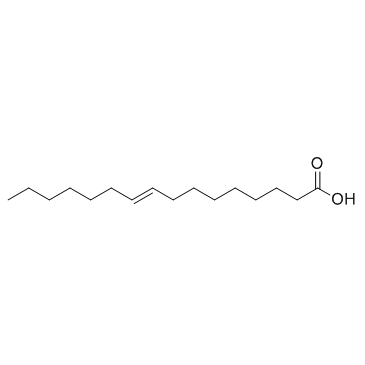Palmitelaidic Acid (9-trans-Hexadecenoic acid) (Synonyms: C16:1(9E), 9-trans-Hexadecenoic Acid) |
| Catalog No.GC33765 |
Palmitelaidic Acid (9-trans-Hexadecenoic acid) (9-trans-Hexadecenoic acid) is the trans isomer of palmitoleic acid.
Products are for research use only. Not for human use. We do not sell to patients.

Cas No.: 10030-73-6
Sample solution is provided at 25 µL, 10mM.
Palmitelaidic acid is the trans isomer of palmitoleic acid. Palmitoleic acid is one of the most abundant fatty acids in serum and tissue.
The monounsaturated fatty acid palmitoleate (palmitoleic acid) is one of the most abundant fatty acids in serum and tissues, particularly adipose tissue and liver. Its endogenous production by stearoyl-CoA desaturase 1 gives rise to its cis isoform, cis-palmitoleate. Palmitoleic acid has been correlated with multiple cardiometabolic risk factors, including high blood pressure, total cholesterol, TGs, apoA-I, apoB, and endothelial dysfunction[1].
Palmitoleic acid promotes a faster uptake of glucose in the body, associated with higher insulin concentration. Palmitoleic acid increases the phosphorylation of AMPK, up-regulates glucokinase and down-regulates SREBP-1. Regarding AMPK downstream, palmitoleic acid increases the production of FGF-21 and stimulates the expression of PPARα[2]. Palmitoleic acid reduces body weight increase, ameliorates the development of hyperglycemia and hypertriglyceridemia, and improves insulin sensitivity. Furthermore, palmitoleic acid down-regulates mRNA expressions of proinflammatory adipocytokine genes (TNFα and resistin) in white adipose tissue and lipogenic genes (SREBP-1, FAS, and SCD-1) in liver[3].
[1]. Frigolet ME, et al. The Role of the Novel Lipokine Palmitoleic Acid in Health and Disease. [2]. de Souza CO, et al. Palmitoleic Acid Improves Metabolic Functions in Fatty Liver by PPARα-Dependent AMPK Activation. J Cell Physiol. 2016 Dec 7. doi: 10.1002/jcp.25715. [3]. Yang ZH, et al. Chronic administration of palmitoleic acid reduces insulin resistance and hepatic lipid accumulation in KK-Ay Mice with genetic type 2 diabetes. Lipids Health Dis. 2011 Jul 21;10:120.
Average Rating: 5 (Based on Reviews and 23 reference(s) in Google Scholar.)
GLPBIO products are for RESEARCH USE ONLY. Please make sure your review or question is research based.
Required fields are marked with *




